Formation Mechanism of Plagioclase–Amphibole and Amphibole–Spinel Symplectites in the Bijigou Layered Intrusion: Insights from Mineralogical and Crystallographic Constraints
Abstract
:1. Introduction
2. Geological Background and Petrography
3. Materials and Methods
3.1. Electron Probe Microanalyzer
3.2. Electron Backscattered Diffraction
4. Results
4.1. Mineral Chemistry
4.2. Crystal Orientation Relationship
5. Discussion
5.1. Symplectite Formation Temperature
5.2. Amphibole + Spinel Symplectite Formation Mechanism
5.3. Plagioclase + Amphibole (Pl2 + Amp2) Symplectite Formation Mechanism
6. Conclusions
Author Contributions
Funding
Data Availability Statement
Conflicts of Interest
References
- Mongkoltip, P.; Ashworth, J.R. Quantitative estimation of an open-system symplectite-forming reaction: Restricted diffusion of Al and Si in coronas around olivine. J. Pet. 1983, 24, 635–661. [Google Scholar] [CrossRef]
- Haselton, J.D.; Nash, W.P. Observations on Titanium in Lunar Oxides and Silicates. Abstr. Lunar Planet. Sci. Conf. 1975, 6, 343. [Google Scholar]
- Ambler, E.P.; Ashley, P.M.; McSween, H.Y. Mineralogy and petrology of the Dutchmans Creek gabbroic intrusion, South Carolina: Discussion and reply. Am. Mineral. 1980, 65, 1302–1306. [Google Scholar]
- Holness, M.B.; Stripp, G.; Humphreys, M.C.S. Silicate liquid Immiscibility within the crystal mush: Late-stage magmatic microstructures in the skaergaard Intrusion, east greenland. J. Pet. 2011, 52, 175–222. [Google Scholar] [CrossRef]
- Namur, O.; Charlier, B.; Holness, M.B. Dual origin of Fe-Ti-P gabbros by immiscibility and fractional crystallization of evolved tholeiitic basalts in the Sept Iles layered intrusion. Lithos 2012, 154, 100–114. [Google Scholar] [CrossRef]
- Keevil, H.A.; Namur, O.; Holness, M.B. Microstructures and late-stage magmatic processes in layered mafic intrusions: Symplectites from the sept iles intrusion, quebec, canada. J. Pet. 2020, 61, egaa071. [Google Scholar] [CrossRef]
- Wang, M.; Wang, C.Y.; Tan, W. Compositional evolution of interstitial liquid after onset of abundant Fe–Ti oxide crystallization in crystal mush: Insights from late-stage microstructures and mineral compositions of the bijigou layered intrusion, central china. J. Pet. 2022, 63, egac025. [Google Scholar] [CrossRef]
- Dong, H.; Wang, C.Y. Microstructures in the Baima layered intrusion, SW China: Constraints on the late-stage magmatic processes during solidification of a crystal mush. J. Asian Earth Sci. 2023, 255, 105774. [Google Scholar] [CrossRef]
- Xie, Q.; Zhang, Z.; Cheng, Z. Interstitial microstructures in Ji’nan mafic intrusion, North China Craton: Magmatic or hydrothermal origin? Eur. J. Mineral. 2017, 29, 839–850. [Google Scholar] [CrossRef]
- Baldwin, J.A.; Powell, R.; White, R.W.; Štípská, P. Ussing calculated chemical potential relationships to account for replacement of kyanite by symplectite in high pressure granulites. J. Metamorph. Geol. 2015, 33, 311–330. [Google Scholar] [CrossRef]
- Dharmapriya, P.L.; Malaviarachchi, S.P.K.; Kriegsman, L.M.; Galli, A.; Dyck, B.; Sajeev, K.; Su, B.-X.; Pitawala, A. Symplectite growth in the presence of alkaline fluids: Evidence from high-aluminous metasediments of the Highland Complex, Sri Lanka. Mineral. Petrol. 2020, 114, 515–538. [Google Scholar] [CrossRef]
- Spruzeniece, L.; Piazolo, S.; Daczko, N.R.; Kilburn, M.R.; Putnis, A. Symplectite formation in the presence of a reactive fluid: Insights from hydrothermal experiments. J. Metamorph. Geol. 2017, 35, 281–299. [Google Scholar] [CrossRef]
- Yudovskaya, M.A.; Kinnaird, J.A.; Costin, G.; McCreesh, M.; Shilovskikh, V.; Kovalchuk, E.; Kuzmin, D. Formation of spinel-orthopyroxene symplectites by reactive melt flow: Examples from the northern Bushveld Complex and implications for mineralization in layered intrusions. Econ. Geol. 2022, 117, 1935–1960. [Google Scholar] [CrossRef]
- Ashworth, J.R.; Chambers, A.D. Symplectic reaction in olivine and the controls of intergrowth spacing in symplectites. J. Pet. 2000, 41, 285–304. [Google Scholar] [CrossRef]
- Yan, D.P.; Zhou, M.F.; Song, H.L. Origin and tectonic significance of a Mesozoic multi-layer over-thrust system within the Yangtze Block (South China). Tectonophysics 2003, 361, 239–254. [Google Scholar] [CrossRef]
- Gao, S.; Ling, W.; Qiu, Y. Contrasting geochemical and Sm-Nd isotopic compositions of Archean metasediments from the Kongling high-grade terrain of the Yangtze craton: Evidence for cratonic evolution and redistribution of REE during crustal anatexis. Geochim. Cosmochim. Acta 1999, 63, 2071–2088. [Google Scholar] [CrossRef]
- Qiu, Y.M.; Gao, S.; McNaughton, N.J.; Groves, D.I.; Ling, W. First evidence of >3.2 Ga continental crust in the Yangtze craton of south China and its implications for Archean crustal evolution and Phanerozoic tectonics. Geology 2000, 28, 11–14. [Google Scholar] [CrossRef]
- Zhou, M.F.; Kennedy, A.K.; Sun, M. Neoproterozoic arc-related mafic Intrusions along the northern, margin of South China: Implications for the accretion of rodinia. J. Geol. 2002, 110, 611–618. [Google Scholar] [CrossRef]
- Zhao, J.H.; Zhou, M.F. Secular evolution of the Neoproterozoic lithospheric mantle underneath the northern margin of the Yangtze Block, South China. Lithos 2009, 107, 152–168. [Google Scholar] [CrossRef]
- Zhao, J.H.; Zhou, M.F. Neoproterozoic adakitic plutons in the northern margin the Yangtze Block, China: Partial melting of a thickened lower crust and implications for secular crustal evolution. Lithos 2008, 104, 231–248. [Google Scholar] [CrossRef]
- Ao, W.H.; Zhang, Y.K.; Zhang, R.Y.; Zhao, Y.; Sun, Y. Neoproterozoic Crustal Accretion of the Northern Margin of Yangtze Plate:Constrains from Geochemical Characteristics, LA-ICP-MS Zircon U-Pb Chronology and Hf Isotopic Compositions of Trondhjemite from Zushidian Area, Hannan Region. Geol. Rev. 2014, 60, 1393–1408. [Google Scholar]
- Wang, M.; Nebel, O.; Wang, C.Y. The flaw in the crustal ‘Zircon archive’: Mixed hf Isotope signatures record progressive contamination of late-stage liquid in mafic-ultramafic layered Intrusions. J. Pet. 2016, 57, 27–52. [Google Scholar] [CrossRef]
- Su, L. Studies of Neoproterozoie Mafie and Ultramafic Intrusionsin Western-Central China and Their Constraints on Breakupof Rodinia Supercontinent; Northwest University: Kirkland, WA, USA, 2004. [Google Scholar]
- Putirka, K. Special collection: Rates and depths of magma ascent on earth: Amphibole thermometers and barometers for igneous systems and some implications for eruption mechanisms of felsic magmas at arc volcanoes. Am. Mineral. 2016, 101, 841–858. [Google Scholar] [CrossRef]
- Zhang, R. Mineral Thermometers and Mineral Manometers; Geological Press: Beijing, China, 1983. [Google Scholar]
- Obata, M.; Ozawa, K. Topotaxic relationships between spinel and pyroxene in kelyphite after garnet in mantle-derived peridotites and their implications to reaction mechanism and kinetics. Mineral. Pet. 2011, 101, 217–224. [Google Scholar] [CrossRef]
- Engvik, A.K.; Putnis, A.; Fitz Gerald, J.D.; Austrheim, H. Albitization of granitic rocks: The mechanism of replacement of oligoclase by albite. Can. Mineral. 2008, 46, 1401–1415. [Google Scholar] [CrossRef]
- Hövelmann, J.; Putnis, A.; Geisler, T.; Schmidt, B.C.; Golla-Schindler, U. The replacement of plagioclase feldspars by albite: Observations from hydrothermal experiments. Contrib. Mineral. Pet. 2010, 159, 43–59. [Google Scholar] [CrossRef]
- Putnis, A.; Putnis, C.V. The mechanism of reequilibration of solids in the presence of a fluid phase. J. Solid State Chem. 2007, 180, 1783–1786. [Google Scholar] [CrossRef]
- Spruzeniece, L.; Piazolo, S.; Maynard-Casely, H.E. Deformation-resembling microstructure created by fluid-mediated dissolution-precipitation reactions. Nat. Commun. 2017, 8, 14032. [Google Scholar] [CrossRef]
- Giuntoli, F.; Menegon, L.; Warren, C.J. Replacement reactions and deformation by dissolution and precipitation processes in amphibolites. J. Metamorph. Geol. 2018, 36, 1263–1286. [Google Scholar] [CrossRef]
- Gratier, J.P.; Dysthe, D.K.; Renard, F. The role of pressure solution creep in the ductility of the Earth’s upper crust. Adv. Geophys. 2013, 54, 47–179. [Google Scholar]
- Hyppolito, T.; García-Casco, A.; Juliani, C.; Meira, V.T.; Hall, C. Late Paleozoic onset of subduction and exhumation at the western margin of Gondwana (Chilenia Terrane): Counterclockwise P-T paths and timing of metamorphism of deep-seated garnet-mica schist and amphibolite of Punta Sirena, Coastal Accretionary Complex, central Chile (34 S). Lithos 2014, 206, 409–434. [Google Scholar]
- Imon, R.; Okudaira, T.; Kanagawa, K. Development of shape-and lattice-preferred orientations of amphibole grains during initial cataclastic deformation and subsequent deformation by dissolution-precipitation creep in amphibolites from the Ryoke metamorphic belt, SW Japan. J. Struct. Geol. 2004, 26, 793–805. [Google Scholar] [CrossRef]
- Pearce, M.A.; Wheeler, J.; Prior, D.J. Relative strength of mafic and felsic rocks during amphibolite facies metamorphism and deformation. J. Struct. Geol. 2011, 33, 662–675. [Google Scholar] [CrossRef]

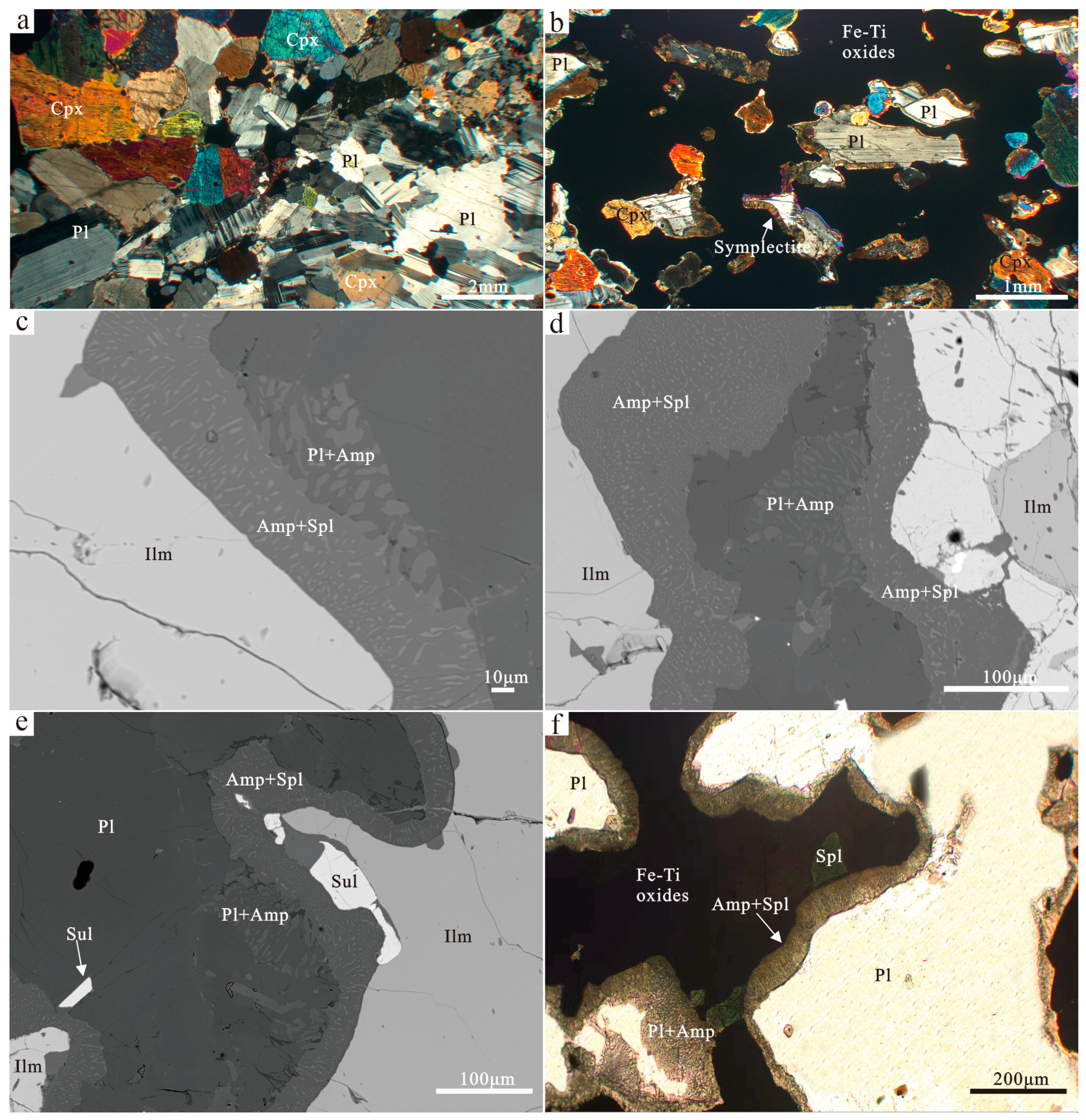
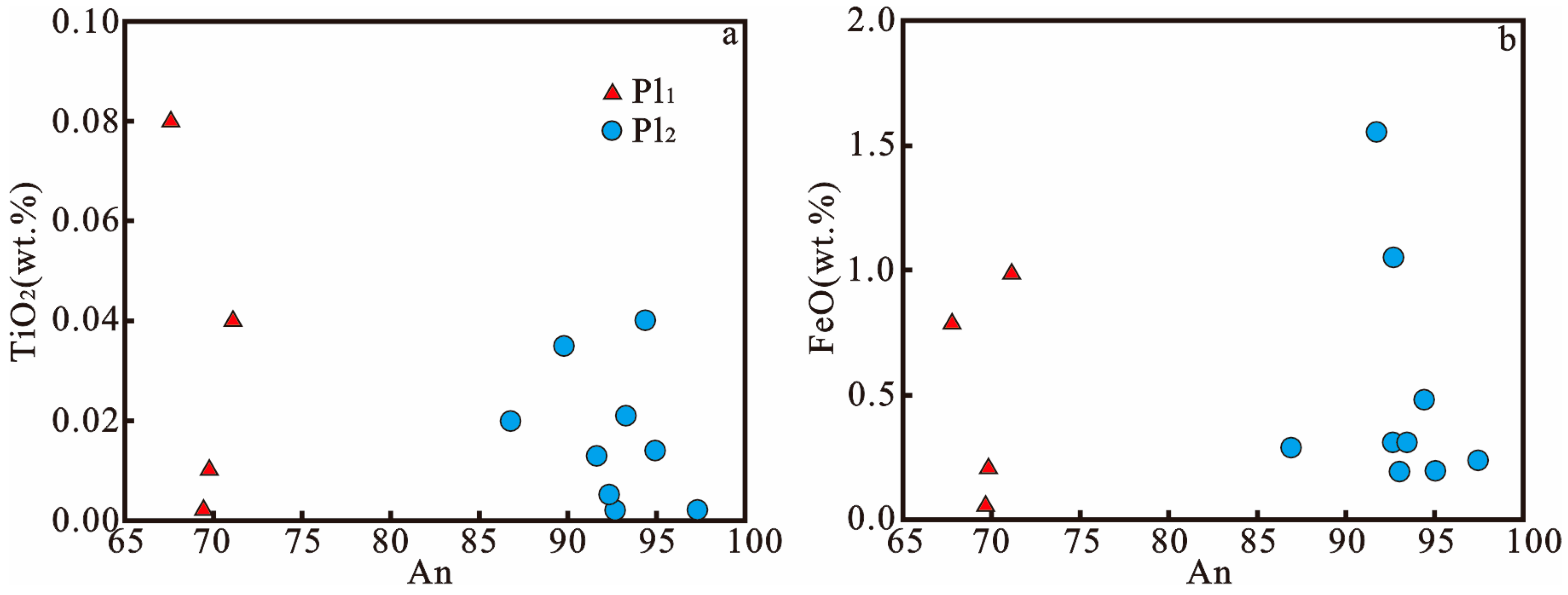
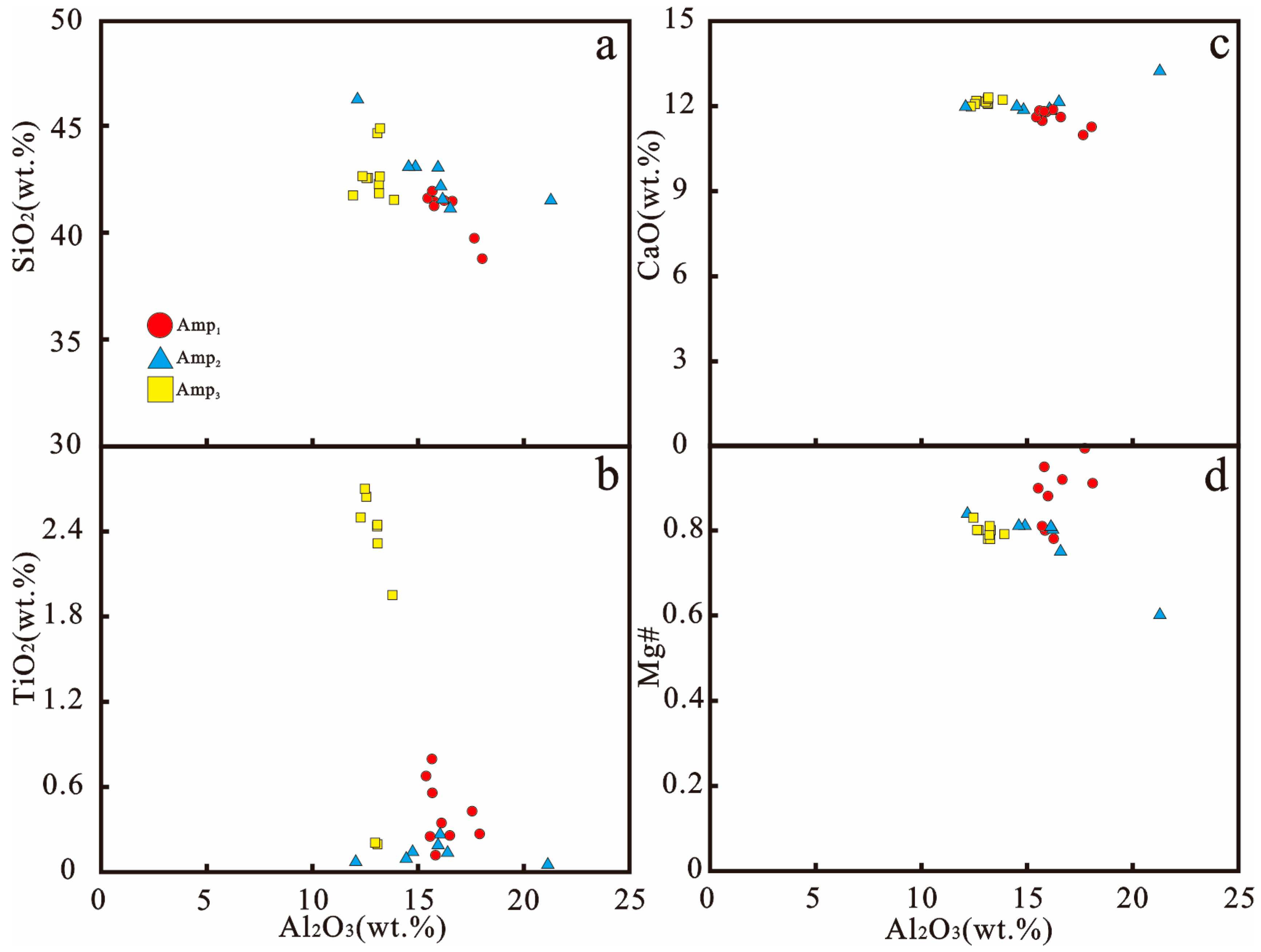
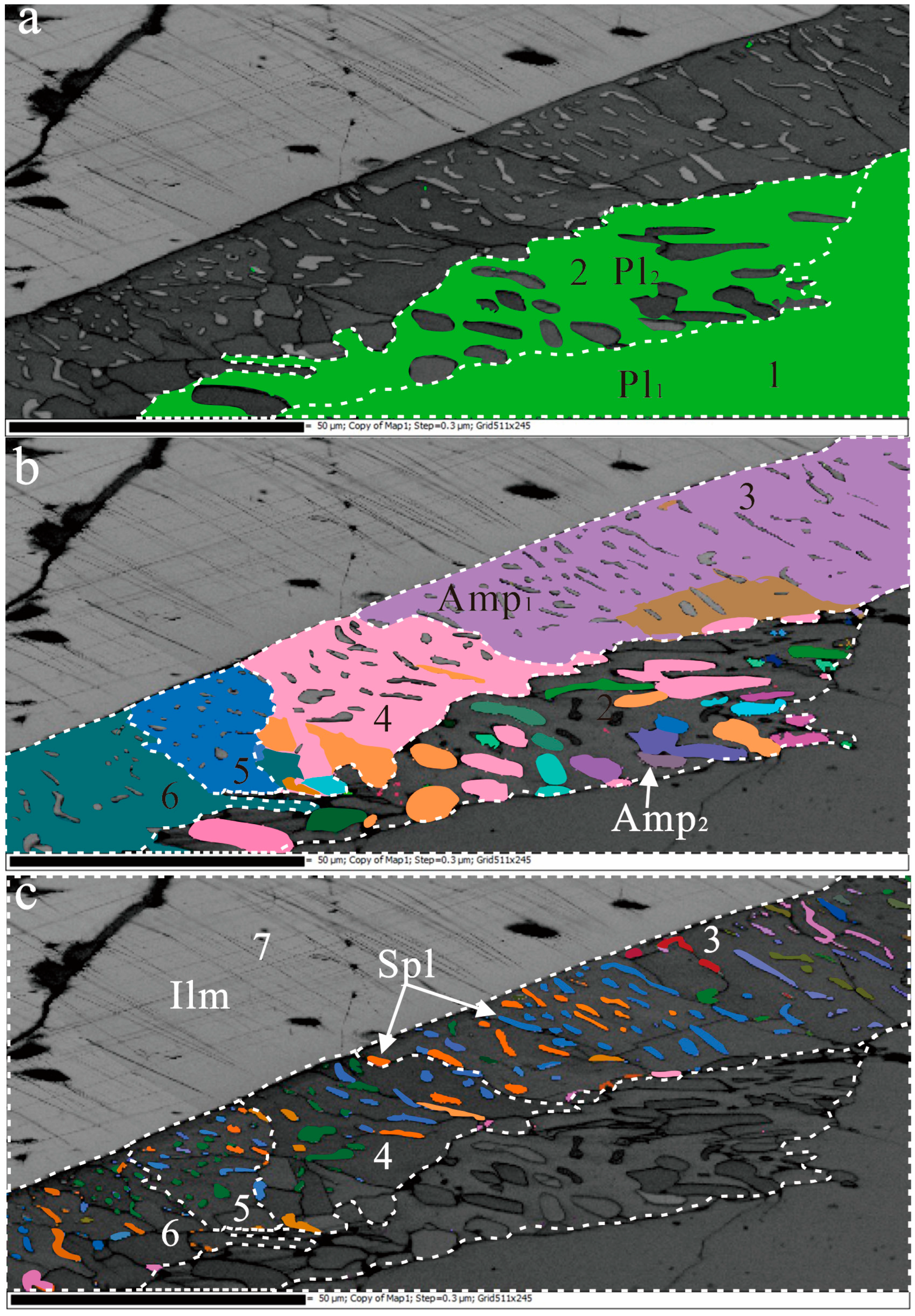
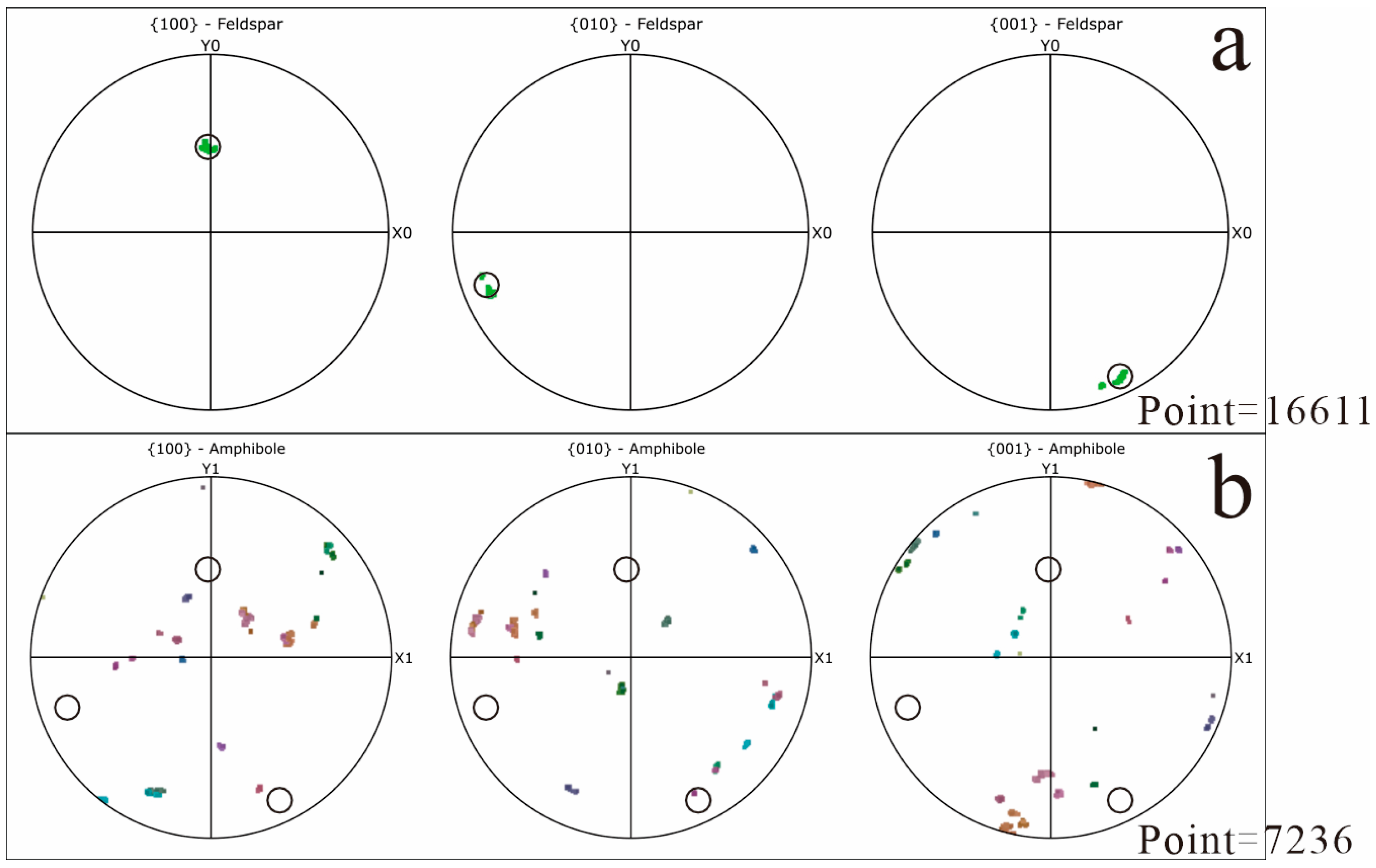
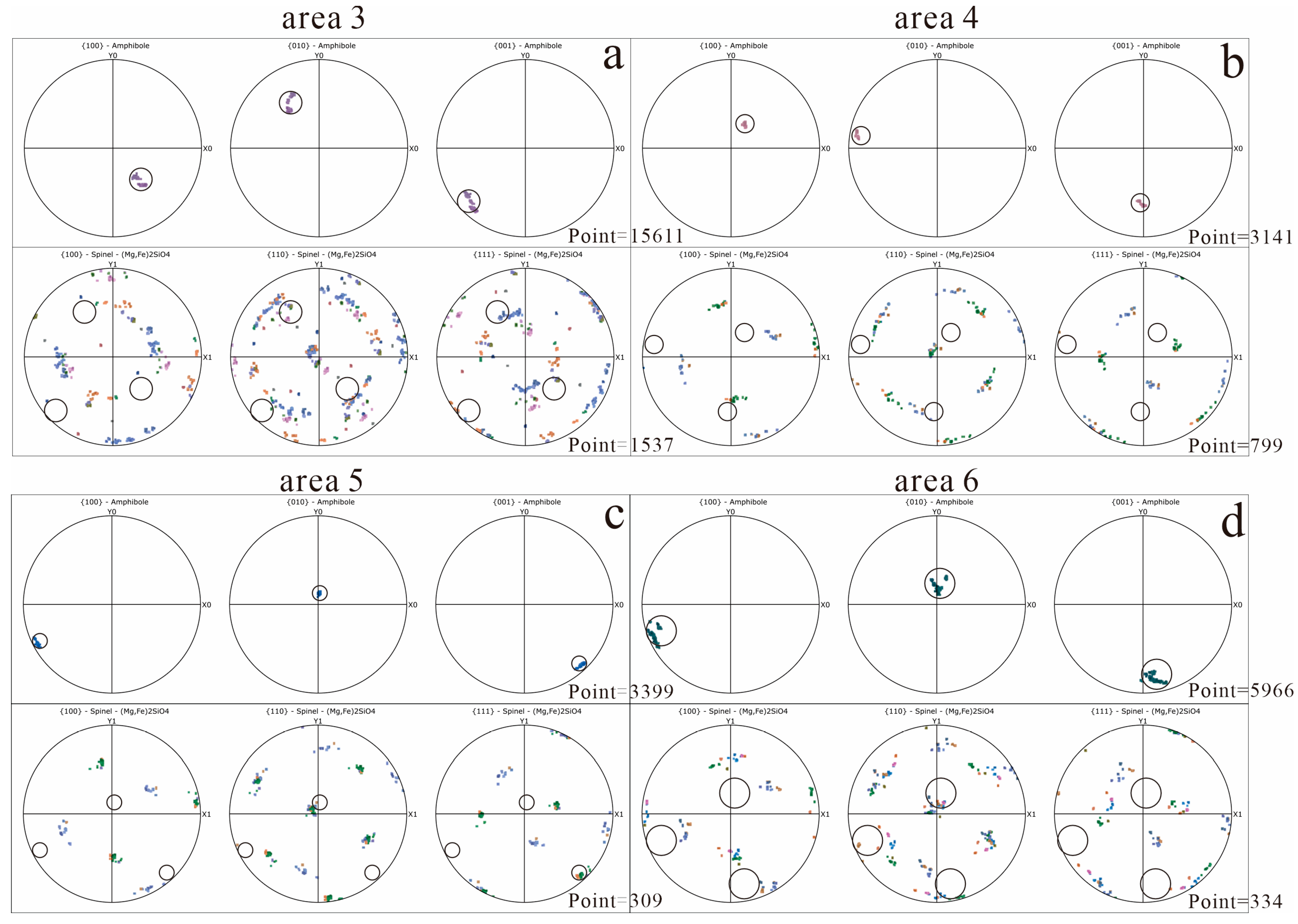



| Sample | 1579-1 | 1579-2 | 1579-9 | 1579-10 | 1579-3 | 1579-4 | 1579-5 | 1579-6 | 1579-7 | 1579-8 | 1579-11 | 1579-12 | 1579-13 |
|---|---|---|---|---|---|---|---|---|---|---|---|---|---|
| SiO2 | 51.32 | 52.12 | 51.61 | 52.02 | 46.21 | 45.60 | 46.17 | 45.43 | 45.20 | 45.54 | 44.84 | 44.86 | 45.86 |
| TiO2 | 0.04 | 0.08 | 0.01 | b.d | b.d | 0.01 | 0.01 | 0.02 | 0.01 | 0.04 | b.d | 0.04 | b.d |
| Al2O3 | 30.21 | 30.61 | 30.99 | 30.84 | 34.70 | 35.01 | 34.33 | 34.59 | 33.24 | 34.96 | 35.40 | 28.98 | 33.17 |
| FeO | 0.99 | 0.80 | 0.21 | 0.07 | 0.21 | 0.21 | 0.33 | 0.32 | 1.57 | 0.49 | 0.26 | 4.03 | 1.07 |
| MnO | b.d | 0.01 | b.d | 0.01 | 0.06 | b.d | 0.12 | 0.23 | 1.72 | 0.07 | 0.03 | 3.87 | 0.90 |
| MgO | 0.44 | 0.01 | 0.03 | b.d | b.d | b.d | 0.02 | 0.01 | 0.03 | b.d | 0.01 | 0.02 | 0.01 |
| CaO | 14.07 | 13.54 | 13.92 | 14.00 | 17.96 | 18.93 | 17.92 | 18.15 | 17.54 | 18.30 | 19.09 | 16.21 | 17.58 |
| Na2O | 3.14 | 3.58 | 3.31 | 3.38 | 0.75 | 0.55 | 0.79 | 0.70 | 0.88 | 0.59 | 0.28 | 0.93 | 0.76 |
| K2O | 0.02 | 0.01 | 0.02 | 0.03 | 0.01 | 0.01 | 0.03 | 0.02 | 0.01 | 0.01 | 0.01 | 0.14 | 0.03 |
| total | 100.22 | 100.75 | 100.09 | 100.34 | 99.90 | 100.32 | 99.69 | 99.47 | 100.19 | 10b.d | 99.91 | 99.06 | 99.39 |
| Si | 2.34 | 2.36 | 2.35 | 2.36 | 2.14 | 2.10 | 2.14 | 2.11 | 2.08 | 2.11 | 2.08 | 2.09 | 2.13 |
| Ti | b.d | b.d | b.d | b.d | b.d | b.d | b.d | b.d | b.d | b.d | b.d | b.d | b.d |
| Al | 1.62 | 1.63 | 1.66 | 1.65 | 1.89 | 1.90 | 1.88 | 1.89 | 1.80 | 1.91 | 1.93 | 1.59 | 1.82 |
| Cr | b.d | b.d | b.d | b.d | b.d | b.d | b.d | b.d | b.d | b.d | b.d | b.d | b.d |
| Fe3+ | b.d | b.d | b.d | b.d | b.d | b.d | b.d | b.d | b.d | b.d | b.d | b.d | b.d |
| Fe2+ | 0.04 | 0.03 | 0.01 | b.d | 0.01 | 0.01 | 0.01 | 0.01 | 0.06 | 0.02 | 0.01 | 0.16 | 0.04 |
| Mn | b.d | b.d | b.d | b.d | b.d | b.d | b.d | b.d | b.d | b.d | b.d | b.d | b.d |
| Mg | 0.03 | b.d | b.d | b.d | b.d | b.d | 0.01 | 0.02 | 0.12 | b.d | b.d | 0.27 | 0.06 |
| Ca | 0.69 | 0.66 | 0.68 | 0.68 | 0.89 | 0.94 | 0.89 | 0.90 | 0.86 | 0.91 | 0.95 | 0.81 | 0.88 |
| Ba | b.d | b.d | b.d | b.d | b.d | b.d | b.d | b.d | b.d | b.d | b.d | b.d | b.d |
| Na | 0.28 | 0.31 | 0.29 | 0.30 | 0.07 | 0.05 | 0.07 | 0.06 | 0.08 | 0.05 | 0.02 | 0.08 | 0.07 |
| K | b.d | b.d | b.d | b.d | b.d | b.d | b.d | b.d | b.d | b.d | b.d | 0.01 | b.d |
| An | 71.14 | 67.64 | 69.81 | 69.51 | 92.93 | 94.97 | 92.56 | 93.32 | 91.66 | 94.38 | 97.40 | 89.81 | 92.55 |
| Ab | 28.77 | 32.32 | 30.06 | 30.33 | 7.02 | 4.97 | 7.28 | 6.54 | 8.29 | 5.54 | 2.57 | 9.30 | 7.25 |
| Or | 0.09 | 0.04 | 0.14 | 0.16 | 0.05 | 0.06 | 0.15 | 0.14 | 0.05 | 0.07 | 0.04 | 0.89 | 0.20 |
| Sample | BJG1579-6 | BJG1579-7 | BJG1579-8 | BJG1579-9 | BJG1579-1 | BJG1579-2 | BJG1579-3 | BJG1579-4 | BJG1579-5 |
|---|---|---|---|---|---|---|---|---|---|
| SiO2 | 41.53 | 39.81 | 41.69 | 41.35 | 46.28 | 43.18 | 42.27 | 43.17 | 43.14 |
| TiO2 | 0.25 | 0.42 | 0.67 | 0.79 | 0.06 | 0.13 | 0.18 | 0.08 | 0.11 |
| Al2O3 | 16.58 | 17.65 | 15.46 | 15.74 | 12.12 | 14.83 | 16.05 | 14.52 | 15.92 |
| FeO | 13.09 | 13.85 | 13.28 | 13.59 | 11.91 | 13.49 | 13.09 | 13.04 | 12.24 |
| MnO | 0.22 | 0.22 | 0.22 | 0.21 | 0.22 | 0.21 | 0.24 | 0.21 | 0.23 |
| MgO | 13.13 | 13.04 | 13.31 | 13.47 | 14.09 | 12.67 | 12.38 | 12.85 | 13.36 |
| CaO | 11.54 | 10.92 | 11.56 | 11.40 | 11.91 | 11.80 | 11.82 | 11.91 | 11.72 |
| Na2O | 2.27 | 2.13 | 2.26 | 2.23 | 1.36 | 1.98 | 2.11 | 1.93 | 2.04 |
| K2O | 0.16 | 0.16 | 0.20 | 0.18 | 0.10 | 0.17 | 0.13 | 0.15 | 0.12 |
| Cl | b.d | b.d | b.d | b.d | 0.01 | b.d | 0.01 | b.d | 0.01 |
| Total | 102.10 | 101.87 | 101.94 | 102.43 | 100.95 | 101.47 | 101.24 | 100.80 | 102.03 |
| Si | 5.87 | 5.64 | 5.92 | 5.84 | 6.56 | 6.16 | 6.04 | 6.20 | 6.07 |
| Aliv | 2.13 | 2.36 | 2.08 | 2.16 | 1.44 | 1.84 | 1.96 | 1.80 | 1.93 |
| Alvi | 0.63 | 0.59 | 0.51 | 0.45 | 0.58 | 0.66 | 0.75 | 0.65 | 0.71 |
| Ti | 0.03 | 0.04 | 0.07 | 0.08 | 0.01 | 0.01 | 0.02 | 0.01 | 0.01 |
| Cr | b.d | b.d | b.d | b.d | b.d | b.d | b.d | b.d | b.d |
| Fe3+ | 1.30 | 1.64 | 1.25 | 1.46 | 0.84 | 0.97 | 0.94 | 0.91 | 1.07 |
| Fe2+ | 0.25 | b.d | 0.32 | 0.15 | 0.57 | 0.64 | 0.62 | 0.66 | 0.37 |
| Mn | 0.03 | 0.03 | 0.03 | 0.02 | 0.03 | 0.03 | 0.03 | 0.03 | 0.03 |
| Mg | 2.77 | 2.75 | 2.82 | 2.83 | 2.98 | 2.69 | 2.64 | 2.75 | 2.80 |
| Ca | 1.75 | 1.66 | 1.76 | 1.72 | 1.81 | 1.80 | 1.81 | 1.83 | 1.77 |
| Na | 0.62 | 0.59 | 0.62 | 0.61 | 0.37 | 0.55 | 0.58 | 0.54 | 0.56 |
| K | 0.03 | 0.03 | 0.04 | 0.03 | 0.02 | 0.03 | 0.02 | 0.03 | 0.02 |
| Mg # | 0.92 | 1.00 | 0.90 | 0.95 | 0.84 | 0.81 | 0.81 | 0.81 | 0.88 |
| Sample | TiO2 | FeO | MnO | NiO | Cr2O3 | CaO | V2O3 | SiO2 | Al2O3 | MgO | Total |
|---|---|---|---|---|---|---|---|---|---|---|---|
| Spl-BJG1579-1 | 0.11 | 26.54 | 0.20 | 0.02 | b.d | 3.07 | 0.01 | 9.58 | 47.17 | 9.34 | 96.03 |
| Spl-BJG1579-2 | b.d | 29.89 | 0.22 | 0.02 | b.d | 0.07 | 0.01 | 0.05 | 57.91 | 8.88 | 97.04 |
| Spl-BJG1579-3 | 0.07 | 31.49 | 0.21 | 0.01 | b.d | 0.05 | b.d | 0.12 | 55.82 | 8.59 | 96.36 |
Disclaimer/Publisher’s Note: The statements, opinions and data contained in all publications are solely those of the individual author(s) and contributor(s) and not of MDPI and/or the editor(s). MDPI and/or the editor(s) disclaim responsibility for any injury to people or property resulting from any ideas, methods, instructions or products referred to in the content. |
© 2025 by the authors. Licensee MDPI, Basel, Switzerland. This article is an open access article distributed under the terms and conditions of the Creative Commons Attribution (CC BY) license (https://creativecommons.org/licenses/by/4.0/).
Share and Cite
Sun, B.; Wei, X.; Dong, H. Formation Mechanism of Plagioclase–Amphibole and Amphibole–Spinel Symplectites in the Bijigou Layered Intrusion: Insights from Mineralogical and Crystallographic Constraints. Minerals 2025, 15, 433. https://doi.org/10.3390/min15050433
Sun B, Wei X, Dong H. Formation Mechanism of Plagioclase–Amphibole and Amphibole–Spinel Symplectites in the Bijigou Layered Intrusion: Insights from Mineralogical and Crystallographic Constraints. Minerals. 2025; 15(5):433. https://doi.org/10.3390/min15050433
Chicago/Turabian StyleSun, Baoqun, Xinyu Wei, and Huan Dong. 2025. "Formation Mechanism of Plagioclase–Amphibole and Amphibole–Spinel Symplectites in the Bijigou Layered Intrusion: Insights from Mineralogical and Crystallographic Constraints" Minerals 15, no. 5: 433. https://doi.org/10.3390/min15050433
APA StyleSun, B., Wei, X., & Dong, H. (2025). Formation Mechanism of Plagioclase–Amphibole and Amphibole–Spinel Symplectites in the Bijigou Layered Intrusion: Insights from Mineralogical and Crystallographic Constraints. Minerals, 15(5), 433. https://doi.org/10.3390/min15050433









